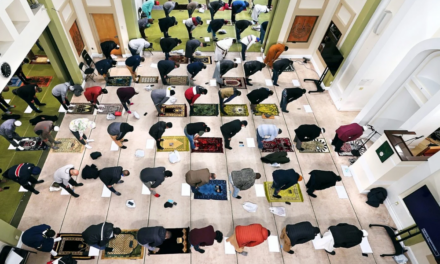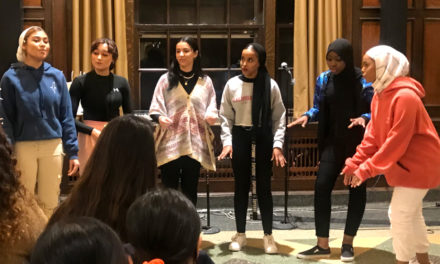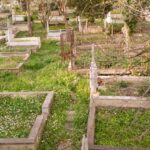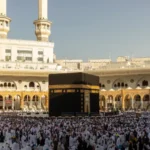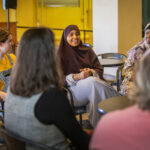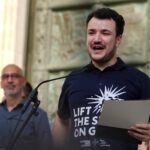Byzantine-era churches destroyed, 7th-century mosques bombed, artists, writers, and musicians killed. Will Gaza’s cultural heritage survive the war?
In late November, intense Israeli shelling destroyed Gaza City’s Central Archive Building, which contained thousands of historical documents dating back over 150 years.
“These documents represent an integral part of our history and culture,” the mayor of Gaza, Yahya Al-Sarraj, said following the incident, highlighting their historical value for the community.
Birzeit University in the occupied West Bank posted photos from inside the heavily damaged municipal building. “The Israeli occupation destroys the central archive of Gaza municipality, executing thousands of historical documents, and deliberately razing all life forms; erasing the city and its history. It is worth noting that the archive holds documents more than a hundred years old,” it said.
The papers housed within the archives held important national records dating back generations and information documenting the history of Gaza and its people, along with plans for Gaza City’s urban development.
“They are targeting our heritage, it’s really scary. We have hundreds of years of history, more than the age of the Israeli state, and they want to obliterate the memory of the place local people belong to.”
“It seems like a continuation of what started in 1948, when historical documents were lost, then the looting of the PLO archive in Beirut during the Israeli invasion in 1982,” Khalil Sayegh, a Palestinian political analyst born and raised in the Gaza Strip, told The New Arab.
Israel’s war on Gaza has had an immense human cost, with nearly 20,000 Palestinians killed, 70% of them women and children. But it has also destroyed numerous historic and cultural buildings such as archaeological sites, museums, cultural centres, markets, ancient churches, and mosques.
Key religious sites struck by airstrikes since Israel’s war began include the Great Omari Mosque, one of the oldest and most important mosques in historical Palestine, that was destroyed – with only its ancient minaret standing – and the bombing of the Church of Saint Porphyrius, which was originally founded in 425 CE.
The mosque, in the heart of Gaza City’s old town, has been a Christian or Muslim holy site since at least the fifth century. The 1,000-year-old Greek Orthodox Church, located in the centre of Gaza, is believed to be the third oldest church in the world.
The Rashad al-Shawwa Historical Cultural Centre, a crucial cultural hub founded in 1985 that hosts a theatre and library holding around 20,000 books, also suffered considerable damage and destruction in airstrikes.
So too have the Palestinian Legislative Council’s (PLC) memorial monument in the Memorial Park for the Unknown Soldier, symbolising the struggle of the Palestinian people, and the 2,000-year-old Roman cemetery discovered last year in northern Gaza, which was almost entirely wiped out by airstrikes.
Anthedon Harbour, Gaza’s first known seaport and one of three Gazan sites on UNESCO’s World Heritage Preliminary List was severely impacted by Israeli strikes, while the main library in Gaza, containing historical documents and books, was partially destroyed.
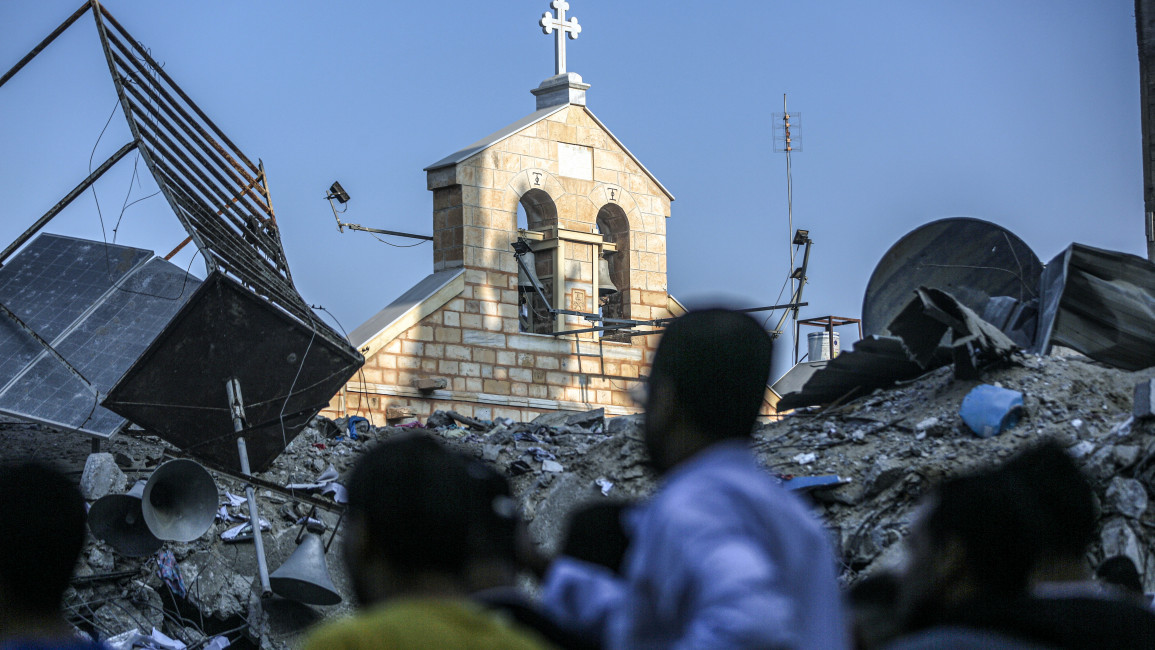
At least eight people were killed in an Israeli airstrike on the Greek Orthodox Saint Porphyrius Church in Gaza City on 20 October, which was sheltering hundreds of Palestinians. [Getty]
At least six key cultural centres have also been damaged, among them the Rafah Museum, a space dedicated to teaching about Gaza’s heritage that housed hundreds of artefacts, which partially collapsed, and Al Qarara Cultural Museum in Khan Younis, which was also badly damaged.
In addition, the Israeli army has destroyed most parts of the Old City of Gaza City, which contained 146-year-old houses and dozens of historical buildings.
Since the beginning of Israel’s war, the Palestinian Authority’s Ministry of Culture has recorded nine publishing houses and libraries bombed, at least 21 cultural centres partially or completely damaged, and 20 historical buildings destroyed and damaged.
The ministry only provided a preliminary assessment of the damage to cultural heritage due to the conditions on the ground making it impossible to obtain comprehensive and precise information and carry out on-site verifications.
A recent survey conducted by Heritage for Peace, an international group of heritage preservation specialists, found more than 100 heritage landmarks partially damaged or entirely destroyed in Gaza since the beginning of the current offensive. The 43-page report details how historic religious monuments, cultural buildings, and archaeological sites have been affected by Israel’s ongoing military activity.
Bothaina Hamdan, who’s in charge of public relations at the Palestinian Culture Ministry, pointed out that Israel’s unprecedented war “attempts to cancel” the Palestinian people’s right to existence.
“They are targeting our heritage, it’s really scary,” Hamdan told TNA. “We have hundreds of years of history, more than the age of the Israeli state, and they want to obliterate the memory of the place local people belong to.”
The public relations officer noted that the war has produced severe human losses among Gaza’s creative professionals, with artists, writers, musicians, and others having been killed or seen their place or work destroyed.
Palestinians say that the deliberate targeting of Gaza’s heritage sites is part of an ongoing effort to suppress Palestinian culture, identity, and, ultimately, their presence on the land.
“From displacement of Palestinians to destruction of heritage sites, it’s all part of a campaign under which no other connection to the land except the Jewish one should be preserved,” political analyst Khalil Sayegh told TNA.
Maher Azmi Abu-Samra, an Amman-based architect originally from Bethlehem, said that destroying historical and cultural heritage has the effect of altering the landscape of the Palestinian territory, depriving its inhabitants of their identity.
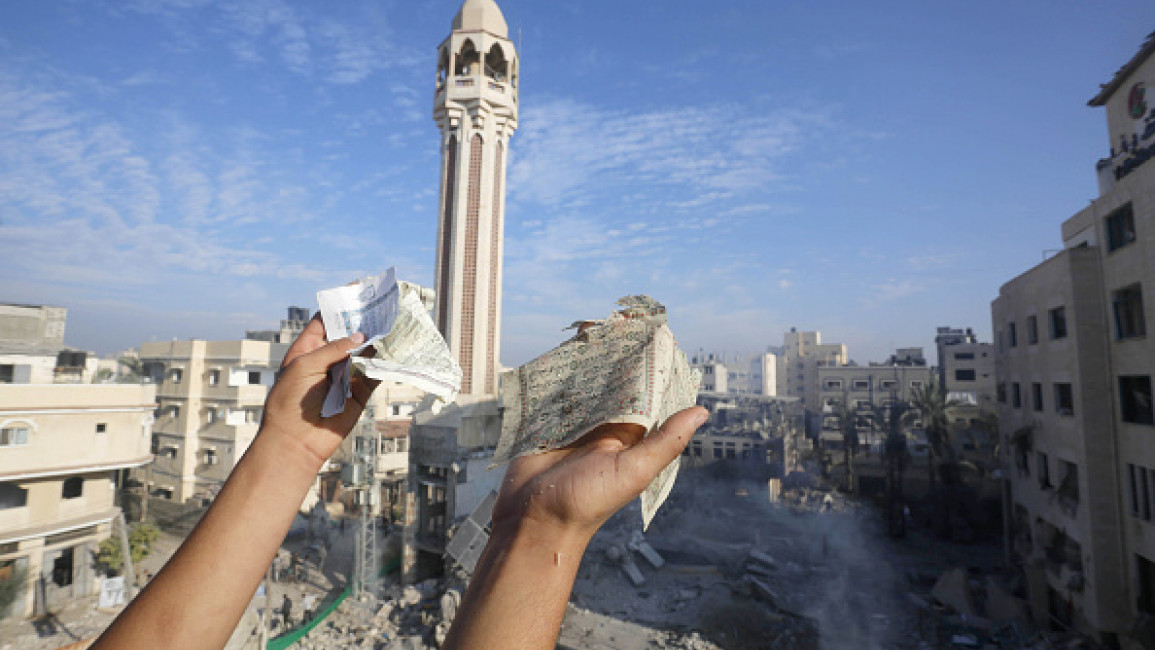
Palestinians collect Qurans near the destroyed Jaffa Great Mosque after Israeli airstrikes in Deir al-Balah, Gaza on 8 December 2023. [Getty]
“Behind such acts of destruction, there is a policy of erasure of the identity of Palestinians,” he told TNA.
“The next generation won’t have any connection with the land, their memory will be erased,” he added, pointing out how this is part of a strategy to permanently displace Palestinians from the besieged coastal enclave.
Drawing a comparison with the Islamic State (IS), the architectural designer said that like the extremist group, the Israeli state is destroying historical landmarks with the view to change the culture of the indigenous people and replace it with “a whole new reality”.
Abu-Samra, who’s among the few architects in the Middle East to design and build using traditional techniques, says that rebuilding ancient structures in their original style won’t be possible. Well-versed in the load-bearing construction method, which does not involve the use of steel and concrete, he said: “This traditional technique has vanished nowadays. We don’t have skilled craftsmen with such know-how who can redo those sites in the old way”.
The Ministry of Culture’s PR officer appealed to the international community to protect and restore critical historical buildings in Gaza. “We call on international organisations to stop this ‘culturecide,’” she said, urging UNESCO to save Gaza’s heritage.
Gaza’s antiques ministry has also recently called on UNESCO to preserve the remaining archaeological and historical sites in the besieged territory.
But even with pledges of foreign aid after Israel’s war ends, it will be almost impossible to rebuild houses and infrastructure with Israel’s blockade in place. Much of Gaza’s rich history and culture, meanwhile, could be lost forever.
Alessandra Bajec is a freelance journalist currently based in Tunis.
Follow her on Twitter:@AlessandraBajec

